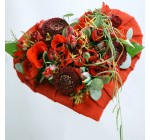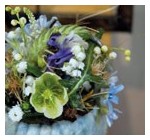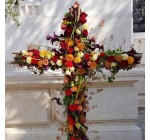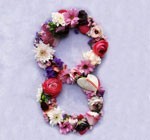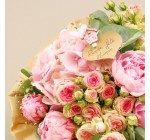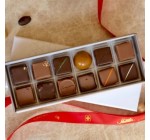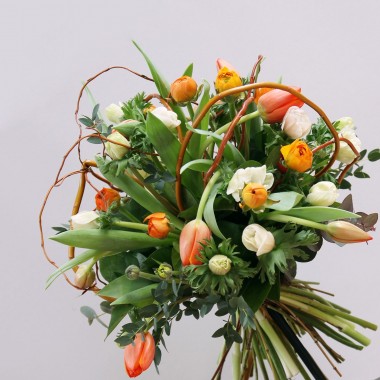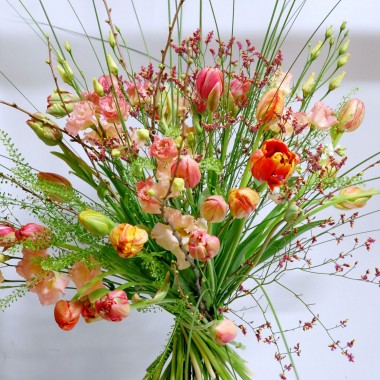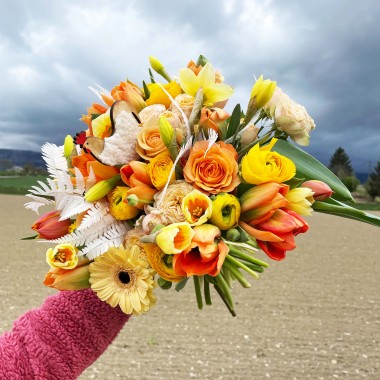- Out-of-Stock
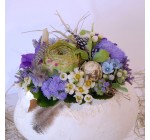
Easter Flower Delivery
The airplane
- Out-of-Stock
Order a bouquet of flowers for Easter and have it delivered to your home from Monday to Saturday
EASTER AT THE FLORISTS
For the Easter festivities, our workshops and the shop are decked out in bright colours. The fields around Bouvard Fleurs are green and our florists enthusiastically create wild arrangements, spring flower plantings, bulbs and bouquets with graceful flowers, as an echo of nature finally waking up. This is an opportunity to take a look at the history of this beautiful festival.
The word Passover (without the S!) is a Hebrew word meaning "passage", Pesah in Hebrew.
Historically, the Jewish Passover commemorates the liberation of the Jewish people from slavery and their departure from Egypt. This time of the year is considered a period of purification, a transition from one state to another, from sin to life. Passover thus marked the return of spring sowing and the birth of lambs, the passage from winter to spring, the resurrection of nature.
Voir plus
Voir moins
In contrast, Easter (with s!) is, in the Christian religion, the feast of the Resurrection of Christ. For Christians, who recognise Jesus as the Messiah, Easter commemorates the resurrection of Jesus, three days after the Last Supper (celebrated on Maundy Thursday), the last meal he had with his disciples on the Jewish Passover, the day before his Passion (the crucifixion, celebrated on Palm Sunday and Good Friday), according to the New Testament. Through his death and resurrection, Christ, the Son of God, redeems man from the bondage of evil and sin. The meaning of Easter is the victory of life over death.
The date of Easter is fixed by the Council of Nicaea on the first Sunday after the first full moon following 21 March. The Western Churches, which have adopted the Gregorian calendar, often celebrate Easter on a different date from the Orthodox Churches, which still use the Julian calendar. The difference can be up to five weeks, depending on the year. According to this rule and depending on the year, Easter can therefore take place between 22 March and 25 April.
An egg story ...
Easter is synonymous with egg hunts and chocolate eggs. However, there is no mention of eggs in the liturgical texts. This custom has pagan origins. The egg is a symbol of life and birth. In many mythologies, the earth and the sky originate from an egg. For example, according to a Chinese myth, the world was born from a turtle egg. In Finnish mythology, a golden egg broke and gave birth to the sky, the earth and the stars. Similar myths come from Phoenicia and Hawaii. Hindu tales also associate the egg with the sun.
The egg can also be a symbol of death and rebirth. For example, many peoples had a funeral custom of placing eggs in their graves. Among Christians, there are several symbolic oppositions between the egg and the cross of Christ. Firstly, the cross refers to death and the egg to life. Secondly, the two symbols evoke different conceptions of temporality: The egg evokes infinity, cyclical time and eternal renewal.
The introduction of eggs into Easter customs dates back to the 12th century, and the first texts referring to them in Europe date back to the 15th century. It is possible that this custom comes from the symbols and virtues associated with eggs.
Another, more pragmatic hypothesis links this tradition to Lent. For forty days, the Church forbids the consumption of eggs. From then on, they had to be cooked in order to preserve them. The eggs were kept until Easter, when they were given to children. Among the Orthodox, the tradition of tapping eggs is present during the Easter mass.
They also began to dye them. The custom of decorating eggs is also very old. In Ukraine, for example, the art of decorating eggs in springtime was developed in prehistoric times. The Egyptians and Persians also used to dye eggs in the colours of spring and give them to their relatives to symbolise the renewal of life. It was the Crusaders who brought this custom to France, having discovered it among the Coptic people.
.. And a rabbit
It seems that the Easter bunny was originally a hare. The Saxons honoured the goddess Eostre in the spring, which gave Easter its name. The hare is the emblem of this goddess, symbolising abundance, proliferation (hares can have a litter every month) and renewal. This beautiful animal has therefore naturally remained associated with Easter. Similarly, in Celtic and Scandinavian traditions, the hare is the pet of the mother goddess, long before the Christian era.
In Germany, around the 15th century, children made nests of leaves, woodland moss and grass and placed them in the garden to celebrate spring.
The myth of the rabbit bringing chocolate eggs to children is based on a legend: A poor woman, unable to offer sweets to her children, decorated and hid eggs in her garden before sending her children there. The children saw a rabbit and thought that it was the rabbit that had laid the eggs. This is how the Easter bunny came to be associated with Easter eggs for the first time. In Belgium, France and Italy, Catholic tradition says that Easter eggs are brought by the Easter bells returning from Rome after Holy Week. For many centuries it has been forbidden to ring the bells from Thursday until Easter Sunday. The legend told to the children says that the bells have gone to Rome where they are blessed by the pope. On their return on Easter Day, they ring again, dropping Easter eggs in the gardens for the children.
In Lorraine and the German-speaking regions, in particular, it is the Easter hare (der Oschterhaas) who scatters eggs and sweets in parks and gardens. This also happens in Alsace (Osterhas).
In Australia, to save the bilby - a small marsupial threatened with extinction - and to fight against the proliferation of rabbits in their country, Australians have been trying to change the legend for a few years: the Easter bunny is now replaced by the Easter bilby to raise awareness among children and to raise funds for the protection of these small marsupials in danger of extinction.
The "chocolate" version of Easter eggs and the famous bunny are relatively "modern" inventions, but the invention of the chocolate egg can be traced back to the 18th century and specifically to the court of King Louis XIV. It seems that the Sun King was the first to order "special" eggs from the court pastry cook to celebrate the arrival of spring. The king's intention was to surprise his courtiers with delicious chocolate eggs. This whim of the king changed the history of pastry forever.
However, as with all the inventions that have become famous in history, the authorship of the Easter egg has several claims. On the one hand, the English claim that the inventor of the Easter egg is John Cadbury, who in 1842 created the "first" chocolate egg to be given to children for Easter, but in reality the real home of the Easter egg seems to be Italy. Several books tell the story of the widow Giambone, owner of a chocolate factory in Turin: around 1725, the lady had the idea of offering her grandchildren a basket full of eggs obtained by filling the shells of hens' eggs with liquid chocolate and honey. She then offered them in her shop and the Easter eggs were so successful that they gradually became a tradition that spread throughout the world.
Also in Turin, at the beginning of the 20th century, the mass production of chocolate Easter eggs was patented thanks to the confectioners of Casa Sartorio who designed a closed hinged mould which, placed in a special machine capable of turning quickly, could distribute the chocolate evenly creating two complementary half-eggs which, once cooled, could be decorated before being assembled to create the real Easter egg.
This also allowed a surprise to be inserted into the egg, a custom that spread very quickly until the post-war boom. Originally, the surprises inside Easter eggs were small animals made of sugar and sugared almonds. Later, the chocolate eggs began to contain real gifts, more or less valuable and sought-after.
The Easter bunny theme is still widely used in the 21st century in popular and children's iconography and on objects such as cards, chocolates, figurines, plush toys, etc.
The image of the rabbit is also very present in florists' shops, and we can easily find it in the form of containers, ceramic or resin figurines, which can be arranged in bouquets and confections.
Celebrate the season
More and more customers like to mark the arrival of spring and take advantage of the Easter festivities to spend time with their families around a beautiful centrepiece or a beautiful seasonal planting.
At this time of year, we offer a multitude of creations made from bulbous plants, such as hyacinths, tulips, muscari, daffodils, narcissus, irises and snowdrops. In our shop, our florists offer many kinds of flowering branches, which bring uniqueness and naturalness to an interior. Among them, we mainly offer cherry, peach, willow, twisted hazelnut (essential for creating an Easter tree!), magnolia and forsythia.
Our bouquets are slender and light. We emphasise the growth of the stems and the lines of the stems in linear creations that gain height.
At this time of year, we create compositions in eggs of all kinds with almost childlike pleasure, combining feathers that dance between the branches in door wreaths of acidic colours. Although the liturgical colours of Easter are traditionally white and yellow, we bring out our best palette of colours to play with cream, pink, tangerine, saffron, apple green...
Our web shop
If you don't have the time to come and admire all our beautiful Easter confections in the shop, our web shop for deliveries throughout Switzerland is also transformed to celebrate spring. Our online shop is full of gift ideas to celebrate Easter in style.
Click, choose your bouquet size, delivery area and recipient, and we'll take care of the rest! From warm or pastel shades, round or slender bouquets, dried flower bouquets, spring mixes, or a bouquet of 100% Genevan tulips, find the perfect present to send throughout Switzerland. Each of our bouquets is made with fresh flowers of the day, always paying attention to their quality.
Easy, fast, high quality and at attractive prices: It has never been easier to send flowers.
You can also choose to accompany your bouquet with a good bottle of Genevan wine, or why not, a delicious box of chocolate eggs, made in the canton with passion and know-how.
The distributor
If you are unable to visit our shop on the day, we have two flower dispensers available for you to use 24 hours a day, 7 days a week (in Perly-Certoux and Carouge). During this busy period, our teams of employees take turns to ensure that the dispensers are always filled with our most beautiful creations.

